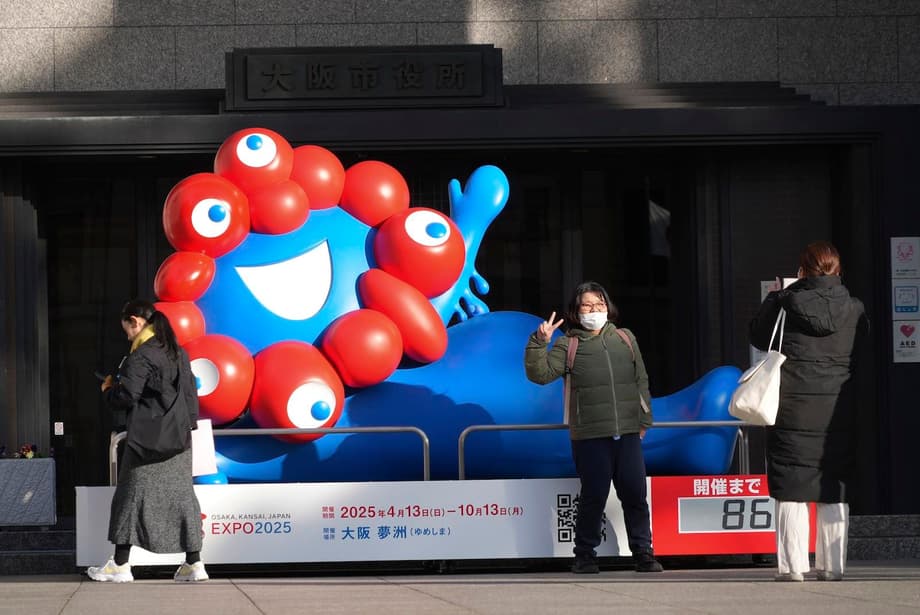From backlash to breakout star
When Osaka set its sights on hosting a global exposition, few expected a surreal creature with a red ring of eyes and a bright blue body to become the event’s signature image. Myakumyaku debuted in 2022 to gasps and jokes. The design looked alien, a smiling void framed by many eyes, perched on a stubby body with flipper arms and a tiny red tail. On social media, the first wave was a chorus of creepy and scary. That reaction did not last. By spring 2025, the same character that once drew shudders was drawing queues. Families formed long lines to hug the mascot, take selfies, and buy a plush before leaving the grounds. Children tugged at sleeves, reluctant to go. The character that bombed at first had become the warm, funny face of Expo 2025 Osaka, Kansai.
Organizers aimed for 28.2 million visitors across the six month run (April 13 to October 13). Midway through September, the count had reached 18.54 million, and by the final day the tally was reported to have topped 22 million. Inside the site on Yumeshima, Myakumyaku was everywhere. It greeted visitors in its dedicated Myakumyaku House, filled shop shelves, and even peered up from manhole covers. A character that once seemed too weird for prime time turned into a meet and greet nobody wanted to miss.
Turning skepticism into affection
The shift was personal for many visitors. Some who once mocked the design changed their minds after meeting the character in motion. Moving eyes and arms, exuberant waves, and the mascot’s unflappable smile softened early impressions.
On a message board inside Myakumyaku House, one visitor summed up the conversion with a handwritten note.
I’m sorry I said you looked terrifying when I first saw you. I like you a lot now.
The apology captured a wider pattern. Initial shock gave way to curiosity, then to fondness once visitors saw the character move and interact.
What is Myakumyaku and why the design matters
Myakumyaku is introduced by the Expo organizers as a mysterious creature born from the fusion of cells and water. The red portions represent cells that split and multiply. The blue mass stands for pure water that changes shape, flows, and adapts. The name itself is based on myaku (pulse), a nod to the heartbeat of life and the idea that knowledge, culture, and technology pass continuously from one generation to the next. Designed by the creative group mountain mountain, led by picture book author and designer Kohei Yamashita, the mascot can shift form and even forget what it looked like a moment before, which fits the event’s theme of constant change and connection. The official profile places its birthplace at a small spring in Kansai, and says it gains energy in sunlight and loves rainy days because it can absorb the rain.
Design symbolism
There is intent behind the wild look. Osaka’s logo for Expo 2025 inspired the circular motif of eyes, and water has long been a symbol of the city. The body is deliberately clumsy and soft. The ring of eyes flips the usual rules of cartoon cuteness. Instead of a round head with a petite face, the face is a hollow space surrounded by watchful eyes. The result is strange and funny at the same time, a recipe that can unsettle at first glance yet becomes endearing with repeated exposure. The character’s official profile even underlines its imperfect charm.
Personality: Friendly but goofy, often making silly mistakes.
Anyone who met the costumed character around the grounds saw that description play out. It tripped a little, waved too hard, posed for countless photos, and blinked its many eyes at toddlers. The gap between concept art and real world performance narrowed as fans interacted with it.
How did the appeal flip so fast
Part of the answer is psychology. People often prefer symmetry in faces and objects. It fits learned ideas of beauty. Yet too much symmetry can feel bland. Designers and models know to add a small quirk, a tilt or off center detail that keeps the eye engaged. Myakumyaku sits much further from symmetry than most characters. It challenged expectations, which explains the early recoil. Then the character’s warmth, availability, and silly antics rewrote the mental script. Visitors did not just see the eyes and odd shapes. They met a cheerful host who looked delighted to meet them.
For cognitive scientists, novelty can create a strong first impression. The challenge is to move from novelty to attachment. Tamami Nakano, a researcher in cognitive neuroinformatics, described Myakumyaku’s singularity in a way many fans later echoed.
We had never seen anything quite like Myakumyaku.
That uniqueness was only the beginning. The mascot became a friendly constant during a sometimes bumpy first stretch for the event. Early on, visitors reported heat, queueing, and online reservation issues. The character’s approachable smile and constant presence offered a light point of human contact. When affection takes hold, what once read as creepy starts to read as goofy and cute.
Merchandising, mobility, and daily sightings
The fandom did not grow by accident. Licensing agreements, retail strategy, and a transport rollout put the character in front of residents and travelers months before the gates opened. By the end of March 2024, 107 companies had signed licensing agreements and roughly 800 official Myakumyaku products were on sale. Those ranged from plush toys and stickers to household goods. Dedicated shops opened in Tokyo, Osaka, and Kyoto, with more outlets added in other regions. International appearances in Melbourne and Ho Chi Minh City turned the mascot into an ambassador well before opening day.
Transport branding made the character familiar in daily life. Wrapped trains on the Osaka Loop Line and JR Yumesaki Line carried Myakumyaku designs starting in November 2023, joined by high speed services in western Japan from April 2024. A special JAL Myakumyaku Jet debuted in late 2023 and flew through spring 2025. For commuters, students, and visiting fans, these sightings made the character feel like a neighbor rather than a stranger.
- Official shops in major cities with exclusive goods and lotteries
- Train wraps in Osaka and a Shinkansen design through the end of the event
- A themed jet from a national carrier through spring 2025
- Pop ups and appearances at events inside and outside Japan
The merchandise strategy kept pace with trends. Late in the run, a collaboration with Labubu, a global figure known for creepy cute styling, arrived as a limited item sold by lottery at the official store inside the site. Fashion collaborations and new T shirts kept demand fresh. Lines formed for a plush lottery in which every participant walked away with a Myakumyaku in one of several sizes. Some limited goods were quickly resold online, a sign of a hard core collector base.
On the ground at the Expo
From day one, the character was a draw. On opening weekend, visitors waited to enter Myakumyaku House for photo sessions and to browse plush toys and accessories. The space served as a simple but effective fan hub, full of red and blue decor and staffed by attendants who managed the steady flow of families eager to pose. The character also appeared around the site at set times, pulling crowds into impromptu parades of selfies.
Visitors publicly wrestled with their change of heart. A woman from Osaka, age 25, admitted that she judged the design when it was first revealed. After seeing the mascot move, she felt differently.
Why did this get picked?
The question faded for many once the character danced, waved, and swiveled its ring of eyes. Skepticism gave way to grins in line. In a separate moment that showed how attached fans had become, a small pavilion reported that its display plush of the mascot had been stolen. Within days, visitors brought donated replacements and gifts, filling the counter with Myakumyaku items to greet the next guests. Pavilion staff thanked the public and put the gifts on display. The scene captured the mood: people wanted the mascot present, smiling, and welcoming visitors.
The six month target of 28.2 million visitors remained ambitious. Average daily attendance of roughly 150,000 would be needed to reach it. That goal put pressure on everything from queue management to nighttime programming. The mascot helped sustain foot traffic to retail areas, and it anchored meet and greet memories that many visitors shared online, boosting word of mouth.
Not always number one
Late in the schedule, the Osaka Healthcare Pavilion hosted a festival that brought dozens of mascots on stage, including characters from across Osaka Prefecture and pavilions from overseas. A popularity poll capped the day. Circular, a bubble like cherub that symbolized a circular economy for the German Pavilion, took first place. It surprised visitors who had expected the official face of the expo to win in a walk. Some insiders suggested that Myakumyaku’s omnipresence may have opened space for a fresher face to top a one day vote. Fans still got what they came for, from music and parades to selfies with the official character and its many friends.
The business behind the smile
Myakumyaku was part heart and part business plan. The event’s operating budget was about 116 billion yen, with most revenue expected from tickets and a meaningful share from merchandise, food, and beverages. Organizers calculated that around 18.4 million tickets would be needed to break even. By early July, sales were reported at about 15.54 million, and the final tally passed 22 million entries by closing day. Licensing revenue from character goods flowed to the Japan Association for the 2025 World Exposition, helping cover costs.
The retail catalog expanded dramatically as the months rolled on. By mid 2025, official items numbered in the thousands. Trains, planes, fashion tie ins, and limited lotteries created peaks of demand. After closing day, the organizer extended sales of official Myakumyaku goods through March 2026 to meet ongoing demand. That decision reflected a broader reality. Popular mascots do not vanish when an event ends. They live on in daily use items, travel cards, and collectibles that keep the story alive for residents and visitors alike.
Why Japan loves mascots
To understand Myakumyaku’s success, it helps to consider Japan’s broader mascot culture. Municipalities, police departments, companies, and prefectures have spent years creating characters to promote public services, tourism, and local foods. The category even has a colloquial name: yuru chara, which suggests loose, laid back personalities. Characters like Kumamon from Kumamoto Prefecture or Rilakkuma the relaxed bear tap into the same instinct that made Myakumyaku work. People enjoy friendly guides that translate institutions into approachable faces.
There is also the appeal of ugly cute, a style known in Japanese pop culture as kimo kawaii. Designs intentionally drift away from traditional cuteness into something odd or mildly grotesque, then invite affection through humor and warmth. Myakumyaku fits that mold. The eyes are too many, the tail is a pomp, the body is soft and wobbly. The charm comes in waves. First a laugh, then a skeptical tilt of the head, then a photo, then a plush at the checkout counter. Add transit sightings, a plane painted in its colors, and a lottery for a special figure, and the character starts to feel like part of daily life in Kansai.
Expo organizers also framed the design as a living metaphor for the theme. Fusion of cells and flowing water aligns with the idea of a future society designed for life. The pulse in the name signals continuity. For an event that asked visitors to imagine how they want to live, a shape shifting, friendly guide proved to be an effective symbol. The official profile even explains that the character sometimes forgets its original form, which is a playful way to talk about change. That spirit matched Osaka’s reinvention of its waterfront with a new island venue and a Grand Ring plaza that gathered people under one sweeping structure.
For those who want to read the official backstory, the profile is available on the event’s site. It lays out the mascot’s abilities, favorite activities, and design intent in simple language and links the character to the expo’s themes of saving lives, empowering lives, and connecting lives. Visitors can still explore archives of designs and programs at the international governing body for Expos.
Expo 2025 official character profile
BIE overview of Expo 2025 Osaka Kansai
At a Glance
- Myakumyaku debuted in 2022 to mixed reactions but became a crowd favorite during Expo 2025 Osaka, Kansai.
- Organizers targeted 28.2 million visitors; attendance exceeded 22 million by closing day.
- The mascot’s design blends cells and water, and the name myaku refers to pulse.
- Licensing had 107 companies and roughly 800 products by March 2024, later growing into the thousands.
- Train and Shinkansen wraps, plus a JAL Myakumyaku Jet, put the character in daily view.
- Myakumyaku House drew long lines for photos and goods, with visitors posting notes of changed hearts.
- Limited collaborations, including a Labubu figure and fashion tie ins, fueled demand and resale activity.
- A mascot poll near the end crowned Circular from the German Pavilion, a reminder that fresh faces can shine in one day events.
- Official goods sales were extended through March 2026 to meet continuing demand.
- Myakumyaku’s arc illustrates the power of ugly cute design and the reach of Japan’s mascot culture.




